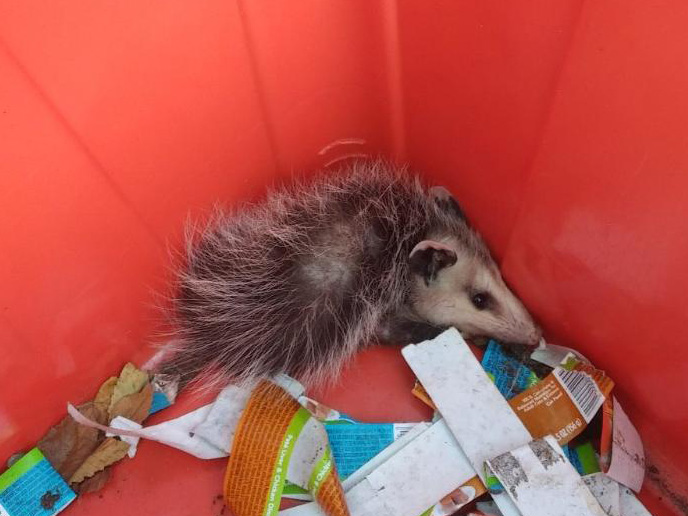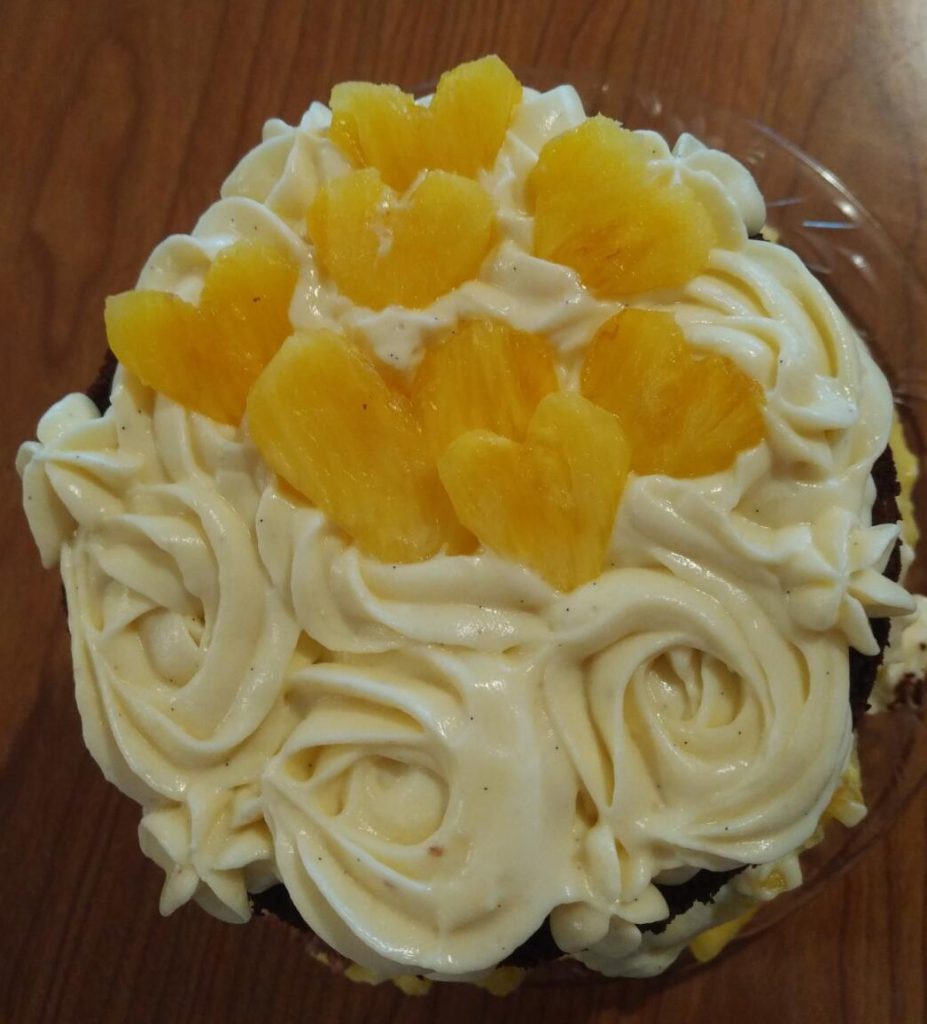It’s not uncommon in Florida in the springtime to stumble across some harried animal mother’s lost child. Like Ashley, here.

You may be tempted to intervene and help, especially if the youngster seems to be in distress. The rule with wild animals, however, is, always,
Keep your distance.
What not to do
Probably don’t do what we did last spring.
We knew the “keep your distance” rule, and Ashley did not seem to be in immediate danger or distressed, precisely. On the other hand, she or he did not seem to be able to get out of the recycling bin, either. Ma Possum was nowhere in sight and was unlikely to return soon, it being daytime. How could we leave a defenseless little woodland creature alone and at the mercy of the neighborhood feral cats? Besides and above all, Ashley was very cute. So we defied the rule and treated the young adventurer to a night’s stay in our Possum B&B, which was a cozy, towel-lined cat carrier in a warm, private room away from the curious cat.
We fed Ashley richly on kefir and cat food and tidbits left over from a cake experiment I was trying in preparation for Mother’s Day. (No, in fact you cannot make a very healthful, plant-forward but nevertheless light and swoonydelicious brown butter chocolate pecan cake with pineapple hearts on top by using the same proportions you use for a carrot cake, subbing shredded beets for carrots. It seems like it should be possible, but it is not. The cake will not turn out all gooey rich but heavenly light-textured like a carrot cake; it will instead be dense and thready and insufficiently sweet. It will have the heft and the personality of an iron bootjack, and nobody will be able to finish a single slice. Whatever. They can’t all be winners.)

Our guest dispatched the dinner we provided, eating every bit of the kefir, the cat food, and the pineapple chunks. Interestingly, Ashley didn’t eat the plate of raw beet shreds so much as chew the juice out of them, leaving a neat stack of damp pink beet-fiber pellets on the plate. (Later the wildlife rehabilitator I called explained that possums do not drink water. They get all their hydration from their food. And beets, while they may not be a crowd favorite, even among possums, let alone Mother’s Day celebrants, do have a lot of water in them.) The Florida Fish and Wildlife Conservation Commission maintains a list of licensed wildlife rehabilitators, available here: https://myfwc.com/conservation/you-conserve/wildlife/injured-orphaned/.
In addition to teaching me all about possum diets, our wildlife rehabilitator also reminded me that it is nearly always best for both the people and the animals involved, if people do not break the rule to keep your distance, for a host of excellent reasons. The baby’s mother may already be on her way back to collect her child, and if a human is on on the scene “helping,” the mother may be too afraid to approach, increasing the baby’s risk of being orphaned. A terrified baby animal might bite the person trying to help it. The animal could be sick or infested with parasites that could endanger people and pets. (We were taking a huge risk bringing our Ashley inside, for instance. Opossums are frequently infested with cat fleas.)
Also, and maybe this is more of an aesthetic concern than a true danger, but it’s still something to consider: it turns out that cute baby animals like Ashley can generate a spectacular amount of very not cute… byproducts. In Ashley’s case, these had a whiff that was nothing short of stunning. After just a short time, the towel we put in the cat carrier with Ashley was in an indescribable condition. Later efforts to rehabilitate it failed, and we finally had to throw it away. There are plenty of reasons, then, that it’s almost always best to resist temptation and remain uninvolved, no matter how cute the baby is.
What to do
- Keep your distance.
That’s what my mother did a few years ago when she found this little slumberer nestled among the ferns in a wild part of her back yard.

Mom followed the distance rule flawlessly despite fervent encouragement to break it. Perhaps unwisely, she had sent me the photo first thing. Well, as soon as I saw that cutie, I knew exactly what to do. I called my mother on the phone and told her to snatch up that fawn immediately, take it into the house, and put it in the bathtub. This would buy me enough time, I explained, to jet over there and build a simple, 12-foot-high pen in the back yard for our new family member. And then my mother could spend the next several years of her life in a 24/7 living re-enactment of The Yearling!
My mother was unable to perceive the many benefits inherent in my plan. She politely declined to follow any of my advice about grabbing the fawn and putting it in the bathtub. She would not pat the fawn on its tiny head or its beautifully dappled flanks. She would not even provide gentle skritches to its velvety ears or boops to its little black nose, so scrupulous was her dedication to the distance rule. She just took that one photo and that was the end of her fawn-related responsibilities, at least as far as she was concerned. She marched off into the house and nothing I could say could change her mind. Sadly, inevitably, when she checked again a few hours later, Flag the Second’s mother had returned from her foraging trip and led the dear little thing away. It was gone forever.
(In case you can’t tell from my tone, that’s actually the goal. Look briefly, maybe take a quick picture, and then get out of there. The next time you look, the baby’s mother will have collected it and led it off home. That’s the best possible outcome, even though if you look too long at the above picture and consider how childishly simple it would have been to make a fawn a comfortable nest in one’s bathtub while one’s daughter built a nice pen for it so that one could have a little deer around brightening up the place for the next five to ten years, it might seem more like a tragedy.)
- Consult the experts.
Explore Ask IFAS publications to get the facts about wildlife species you’re likely to find.
If an animal is injured or sick or if you’ve waited a day or two and the mother has not returned, contact a wildlife rehabilitator.
- Make your yard a safe haven for wild creatures!
Want to provide a daycare resource for busy wildlife parents? Explore strategies in the Ask IFAS publications “Landscaping Backyards for Wildlife: Top Ten Tips for Success” and “Rethinking Wildlife in Your Florida-Friendly Edible Landscape.”
What happened to Ashley
You’re probably wondering how that story ends. I’m pleased to report that it ends well, thanks to our kindly and patient wildlife rehabilitator. Following her advice, on Ashley’s second night with us we left the cat carrier out in the yard near where we first spotted him or her. We propped the door open so that Ashley could leave at will or Ashley’s mom could easily come retrieve her child.
When I checked the cat carrier early the next morning, though, Ashley was still there, burrowed into the towel against the cold. I pulled the little possum out onto the grass. (She or he appeared to have died in the night, but I suspected it was a ruse.) Still following the advice of the rehabilitator, I palpated very gently and found that Ashley’s tiny backbone and fragile ribs were easily discernible, which might, according to the rehabilitator, be a sign of malnutrition. So I brought our possum guest back inside and served up a hearty breakfast. More kefir! A sardine! More beet shreds! A fat, glossy strawberry! And another several hours of peaceful napping curled up in the soft, smelly towel in the warm, quiet house.
Ashley’s trouble seems to have been exhaustion more than hunger because the breakfast went untouched but the possum was nevertheless a lot more lively by that evening. A couple of hours before sunset, we took the cat carrier outside to give it and its inhabitant a bath. (The rehabilitator said it would be a good idea, that possums are not known for their clean habits–and boy is that ever right). Ashley no longer appeared to be deceased and in fact was alert and energetic, a changed animal. We set him or her down in a sunny spot to await bathtime, intending to deal with the cat carrier first. But bathtime never came for our Ashley because the instant his or her feet touched the grass, Ashley vacated the premises, streaking away across the backyard, through the fence, and under the neighbor’s woodpile, which seemed perhaps to be familiar territory. It is our hope that in fact the woodpile was home, and that Ashley was reunited that instant with mother and siblings and never separated again until the day he or she left to start a new possum family.
And now it is spring again, and each time I wash filthy little footprints off the porch after a possum has been Scrooge McDucking it in the compost pile diving for fermented strawberries or delicious black soldier fly larvae, I assume that that possum was Ashley, our little guest, all grown up and paying us a call.
Source: UF/IFAS Pest Alert
Note: All images and contents are the property of UF/IFAS.



